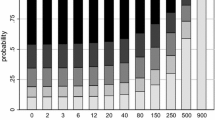Abstract
Water consumption and disposal are often taken for granted as essential services with required levels of service quality, yet little is known about how much consumers are willing to pay for specific service levels. As customers in many countries face changing levels of water availability (especially shortages linked possibly to climate change and limited catchment capacity), the need to assess the value (and hence benefit) to society of varying service levels and prices in an effort to secure the provision of and disposal of water has risen on public agendas. In an attempt to establish how much customers are willing to pay for specific levels of service, we use a series of stated choice experiments and mixed logit models to establish the willingness to pay to avoid interruptions in water service and overflows of wastewater, differentiated by the frequency, timing and duration of these events. The empirical evidence is an important input into the regulatory process for establishing service levels and tariffs, as well as useful planning information for agencies charged with finding cost effective ways of delivering services at prices that customers deem to be value for money.
Similar content being viewed by others
References
C. Bhat (2001) ArticleTitle‘Quasi-random Maximum Simulated Likelihood Estimation of the Mixed Multinomial Logit Model’ Transportation Research B. 35 677–693 Occurrence Handle10.1016/S0191-2615(00)00014-X
Burgess, L. and D. Street (2004a) ‘Optimal Designs for 2k Choice Experiments,’ Communications in Statistics – Theory and Methods, forthcoming
Burgess, L. and D. Street (2004b) ‘Optimal Designs for Choice Experiments with Asymmetric Attributes,’ working paper, Department of Mathematical Sciences, University of Technology Sydney
Y. Cai I. Deilami K. Train (1998) ArticleTitle‘Customer Retention in a Competitive Power Market: Analysis of a “Double-Bounded Plus Follow-ups’ Questionnaire” The Energy Journal 19 IssueID2 191–215
R. Carson T. Groves M. Machina (2003) Incentive and Informational Properties of Preference Questions, working paper Department of Economics. University of California San Diego
R. Carson T. Groves J. List M. Machina (2004) “Probabilistic Influence and Supplemental Benefits: A Field Test of the Two Key Assumptions Underlying Stated Preferences,” working paper Department of Economics. University of California San Diego
J. Eto J. Koomey B. Lehman N. Martin E. Mills C. Webber E. Worrell (2001) Scoping Study on Trends in the Economic Value of Electricity Reliability to the U.S. Economy, technical report Energy Analysis Department Lawrence Berkeley Laboratory, Berkeley California
A. Goett K. Hudson K. Train (2000) ArticleTitle‘Customers’ Choice Among Retail Energy Suppliers: The Willingness-to-Pay for Service Attributes’ The Energy Journal 21 IssueID4 1–28
V. Hajivassiliou P. Ruud (1994) ‘Classical Estimation Methods for LDV Models using Simulation’ R. Engle D. McFadden (Eds) Handbook of Econometrics. North-Holland Amsterdam
D. Hensher (2001) ArticleTitle‘Evaluation of Commuter Travel Time Savings for Car Drivers in New Zealand: Evaluating Alternative Model Specifications’ Transportation 28 110–118 Occurrence Handle10.1023/A:1010302117979
Hensher D. A. (2004) How do Respondents Handle Stated Choice Experiments? - Information processing strategies under varying information load, DoD Paper #5, Institute of Transport Studies, The University of Sydney, March
D. Hensher W. Greene J. Rose (2004) “Deriving Willingness to Pay Estimates from Observation Specific Parameters using Classical Methods,” working paper Institute of Transport Studies University of Sydney
L. Lee (1995) ArticleTitle‘Asymptotic Bias in Simulated Maximum Likelihood Estimation of Discrete Choice Models’ Econometric Theory 11 437–483 Occurrence Handle10.1017/S0266466600009361
J. Louviere (2003) “Random Utility Theory-Based Stated Preference Elicitation Methods: Applications in Health Economics with Special Reference to Combining Sources of Preference Data, keynote address Australian Health Economics Society Conference Canberra
J. Louviere D. Hensher J. Swait (2000) Stated Choice Methods: Analysis and Applications Cambridge University Press New York
Louviere J., H. Oppewal, H. Timmermans and T. Thomas (2003) ‘Handling Large Numbers of Attributes in Conjoint Applications,’ working paper
D. McFadden (1974) ‘Conditional Logit Analysis of Qualitative Choice Behavior’ P. Zarembka (Eds) Frontiers in Econometrics’. Academic Press New York
D. McFadden K. Train (2000) ArticleTitle‘Mixed MNL Models for Discrete Response’ Journal of Applied Econometrics 15 IssueID5 447–470 Occurrence Handle10.1002/1099-1255(200009/10)15:5<447::AID-JAE570>3.0.CO;2-1
D. Revelt K. Train (1998) ArticleTitle‘Mixed Logit with Repeated Choices: Households’ Choices of Appliance Efficiency Level’ Review of Economics and Statistics LXXX IssueID4 647–657
Z. Sándor M. Wedel (2001) ArticleTitle‘Designing Conjoint Choice Experiments Using Managers’ Prior Beliefs’ Journal of Marketing Research 36 430–444
G. Sonnier A. Ainslie T. Otter (2003) “The Influence of Brand Image and Product Style on Consumer Brand Valuations,” working paper, Anderson Graduate School of Management University of California Los Angeles
D. Street D. Bunch B. Moore (2001) ArticleTitle‘Optimal Designs for 2k Paired Comparison Experiments’ Communications in Statistics – Theory and Method 30 2149–2171
K. Train (2000) Halton Sequences for Mixed Logit, Working Paper, Department of Economics University of California Berkeley
K. Train (2003) Discrete Choice Methods with Simulation Cambridge University Press New York
K. Train M. Weeks (2004) “Discrete Choice Models in Preference Space and Willingness-to-Pay Space,” working paper, Department of Economics University of California Berkeley
Author information
Authors and Affiliations
Corresponding author
Rights and permissions
About this article
Cite this article
Hensher, D., Shore, N. & Train, K. Households’ Willingness to Pay for Water Service Attributes. Environ Resource Econ 32, 509–531 (2005). https://doi.org/10.1007/s10640-005-7686-7
Accepted:
Issue Date:
DOI: https://doi.org/10.1007/s10640-005-7686-7



